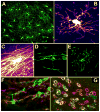NG2-glia as multipotent neural stem cells: fact or fantasy?
- PMID: 21609823
- PMCID: PMC3119948
- DOI: 10.1016/j.neuron.2011.05.013
NG2-glia as multipotent neural stem cells: fact or fantasy?
Abstract
Cycling glial precursors-"NG2-glia"-are abundant in the developing and mature central nervous system (CNS). During development, they generate oligodendrocytes. In culture, they can revert to a multipotent state, suggesting that they might have latent stem cell potential that could be harnessed to treat neurodegenerative disease. This hope has been subdued recently by a series of fate-mapping studies that cast NG2-glia as dedicated oligodendrocyte precursors in the healthy adult CNS-though rare, neuron production in the piriform cortex remains a possibility. Following CNS damage, the repertoire of NG2-glia expands to include Schwann cells and possibly astrocytes-but so far not neurons. This reaffirms the central role of NG2-glia in myelin repair. The realization that oligodendrocyte generation continues throughout normal adulthood has seeded the idea that myelin genesis might also be involved in neural plasticity. We review these developments, highlighting areas of current interest, contention, and speculation.
Copyright © 2011 Elsevier Inc. All rights reserved.
Figures

References
-
- Barnabe-Heider F, Goritz C, Sabelström H, Takebayashi H, Pfrieger FW, Meletis K, Frisen J. Origin of new glial cells in intact and injured adult spinal cord. Cell Stem Cell. 2010;7:470–482. - PubMed
-
- Barres BA, Koroshetz WJ, Swartz KJ, Chun LL, Corey DP. Ion channel expression by white matter glia: the O-2A glial progenitor cell. Neuron. 1990;4:507–524. - PubMed
Publication types
MeSH terms
Grants and funding
LinkOut - more resources
Full Text Sources
Other Literature Sources
Miscellaneous

